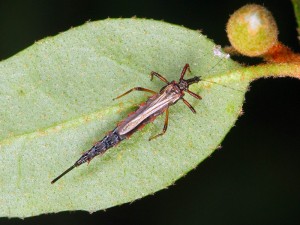Order Thysanoptera

Thrips are another group of insects that have gained what isn’t always a justified reputation as a pest. Yes, there are some species that cause damage in commercial crops and private gardens, but it is mostly the handful of introduced species that are to blame for this. There are around 740 thrip species in Australia and the vast majority are actually more beneficial than harmful.
Thrips typically have an elongated, cylindrical body. The largest species can reach 15 millimetres and the smallest species are less than 1 millimetre. Not all species have wings, but those that do have two pairs that are fringed with hairs. They have mouthparts made up of stylets, which allows them to either rasp or suck their food.

at various stages of development.
As with some of the other invertebrates, thrips don’t necessarily require a male and female to reproduce. Parthenogenesis is the process in which females can be produced from unfertilised eggs, so it is thought that some thrip species may not have any males at all. When the young hatch from their eggs, which are laid on plants, they look pretty much like the adults but without wings. They only moult a few times, then go through a prepupal and pupal stage before becoming full adults, the whole process taking a few weeks or so. Several generations can be produced within a year.
The diet varies from species to species. As I mentioned, some pest species attack fruit crops or damage garden flowers, but others provide a great service by preying on other small garden pests like scale insects. A few species feed on fungus and others prefer flowers and pollen.
Almost all Australian thrip species are found along the east coast of the continent.
~~~~~
Click here to see the Thrip photo galleries
~~~~~